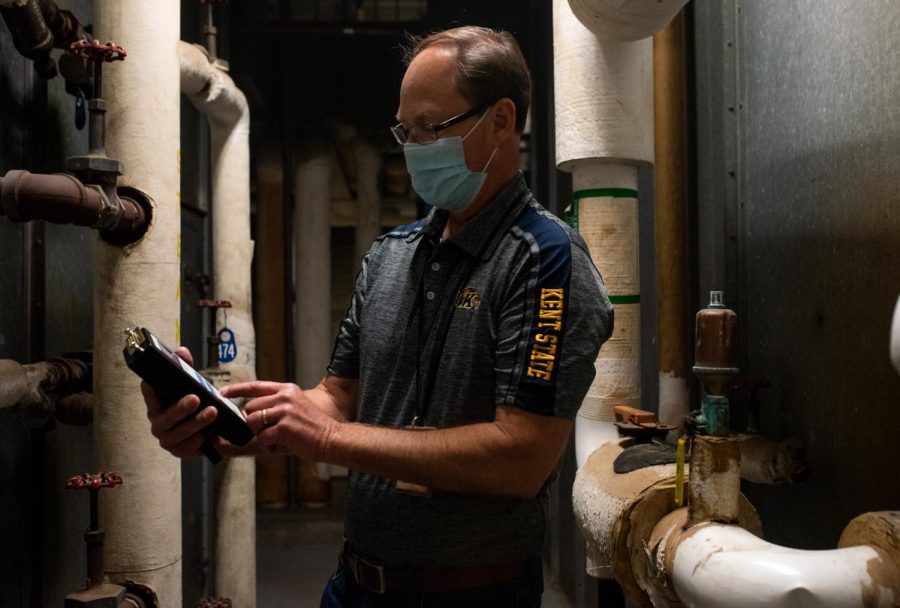Residence halls lack ionization technology, fight against Covid-19
September 19, 2021
Classroom chairs fill the space with masked students this fall as in-person classes return to Kent State, dining hall lines stretch across the room while undergraduates wait for dinner and residence halls echo the sound of roommates who share a laugh together.
In the background of this progressive change,needlepoint bipolar ionization units distribute charged ions into the air from the building’s ventilation system to kill the Covid-19 virus.
Ions are molecules that are positively or negatively charged and occur through nature that works to clean outside air. The needlepoint bipolar ionization technology generates indoor ions to create clean air.
Inside activity is now underway. The university began installing the units as early as May 2020. When open-air student seating took place in tents a year ago, the university installed the devices in empty dining halls.
“We researched the number of different technologies, and one of our efforts to control the spread of Covid is the use of needlepoint bipolar ionization,” said Doug Pearson, associate vice president of facilities planning and operations.
Over 1,000 units in total, Kent State’s board of trustees approved $3 million from the Higher Education Emergency Relief Fund in June of 2020, which covers the cost of the units and the labor for installation. The university plans to purchase additional ion testing devices for monthly maintenance checks with some of the $175,000 left.
Included in the purchase are 250 portable units that plug into the wall, costing almost $1,000 each and distributing ions into the selected area. The additional units are larger sets, cost nearly $10,000 each and are installed in the building’s air handlers, which allows ions to be distributed throughout the structure.
Across Kent State’s 10 campuses, select lecture halls, dining halls and athletic areas are included in the university’s installation plan, but where do residence halls fit into the layout?
With 24 residence halls on Kent’s main campus, four buildings are fully ionized with needlepoint bipolar ionization technology. Centennial E and Centennial F include the nearly 300-bed designated isolation area for students required to quarantine. Verder Hall is a potential quarantine spot this winter and is currently closed because the building lacks air-conditioning. Korb Hall was a potential isolation area but is used as a dorm with student occupancy.
As far as sending Covid-19 positive students to places where the virus is inactive because of installed ionization units, “they’re relocated to isolation rooms,” Pearson said.
Robert Misbrener, project manager II from Kent State’s office of the university architect, said he and his team have been discussing some potential reasons why most residence halls do not have the units.
“The residence hall leadership has not doubled up on all spaces like they have,” Misbrener said. “They don’t have as many students in each room as they usually did.”
For parents like Marilyn Shimp, sending her freshman daughter to college this fall brought fear amid the pandemic, but having her child vaccinated eased her mind. Even with preparation, she said it’s still nerve-racking and she doesn’t understand why the university is not installing the units in dorms.
“Residence halls are the only [places] where they’re not wearing masks,” she said. “That’s where they should be first.
Last year, the university changed the layout of many dorm rooms. Infact, 183 triples, which sleeps three students, and four quads, sleeping four students, were converted to doubles, holding two students, according to an email from David Taylor, the senior director of residence services. Some multi-occupancy rooms were eliminated altogether when Van Campen Hall was converted into office space. Other dorms like Korb Hall and some Eastway locations were reduced to single occupancy.
That being said, there are 21 open halls and the student-occupancy rate is just above 99% as of Aug.18 move-in day. Taking a closer look inside some dorms, 238 students currently live in Prentice Hall, having a little more than 99% capacity, which is slightly less than the 2019-2020 school year that allowed 245 students.
Mariah Johnson, a senior who is studying visual communication design, is one of the 238 students living in the hall. She just returned to the dorm for a second year. Last year, it was a ghost town, she said. But this year is different.
“So far I’ve seen a decent amount of people,” she added. “It’s definitely a lot more people than I saw when I had like a single room to myself.”
Dunbar Hall is another example. Shimp’s daughter moved into the dorm last month with 240 other students, reaching capacity of more than 98%, whereas 251 people were full capacity in 2019-2020.
Currently, the university does not plan to install the units into residence halls and is moving beyond the dorms, Pearson said
Other buildings lacking the ionization unit include structures with science labs, such as Cunningham Hall, Smith Hall, Williams Hall and the Integrated Science Building.
“If you’re doing an experiment with germs like MRSA” the units will inactivate the experiment, Misbrener said.
Some office spaces include the device but the “initial goal was not to serve every office, just the places that have instruction,” Pearson said. Places where “multiple people in a single space” reside, like a classroom.
Athletic areas where people congregate together, including locker rooms, weight rooms and the field houses’ lobby area, have installed units.
Other high-trafficked areas that have the technology are the Student Center’s second floor touring area, the May 4th Visitor Center, and multiple dance studios throughout campus.
“It’s sort of a multi-faceted approach with social distancing, masks, testing, vaccination and modifications to the HVAC system, which is our needlepoint bipolar ionization,” Pearson said.
Kelly Krabillis an assigning editor. Contact her at [email protected].












